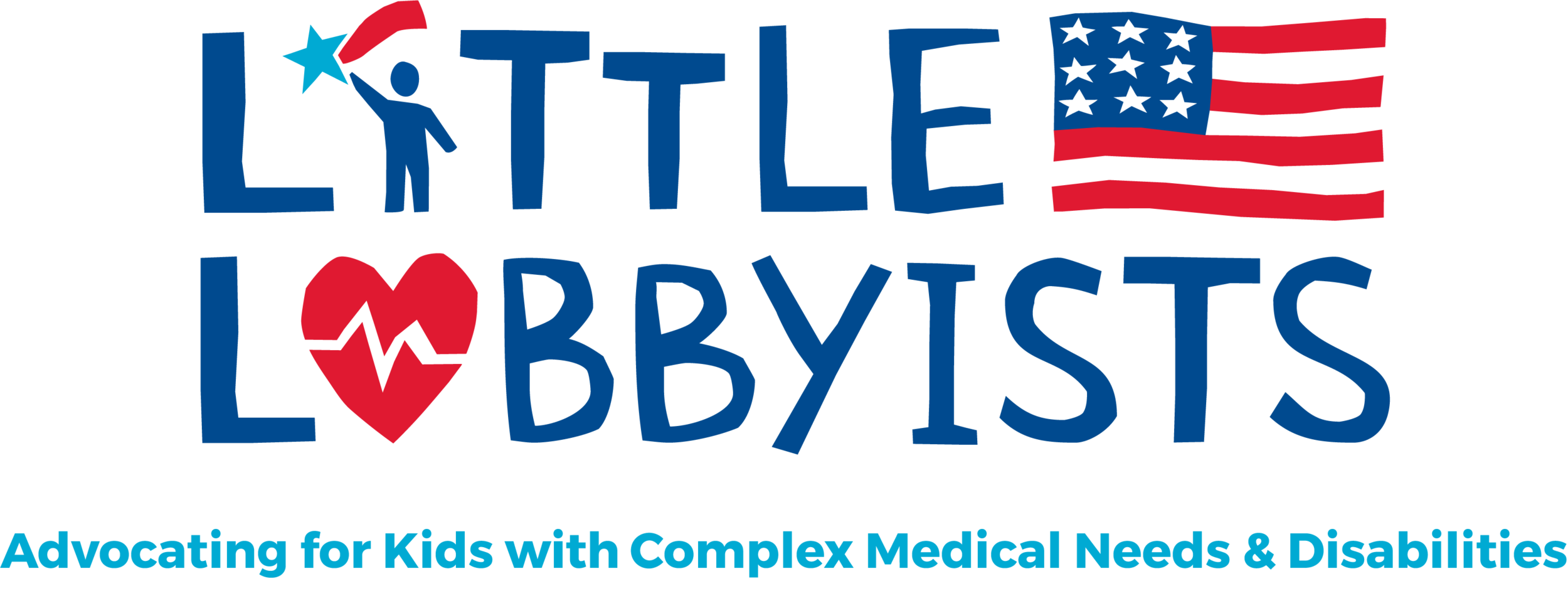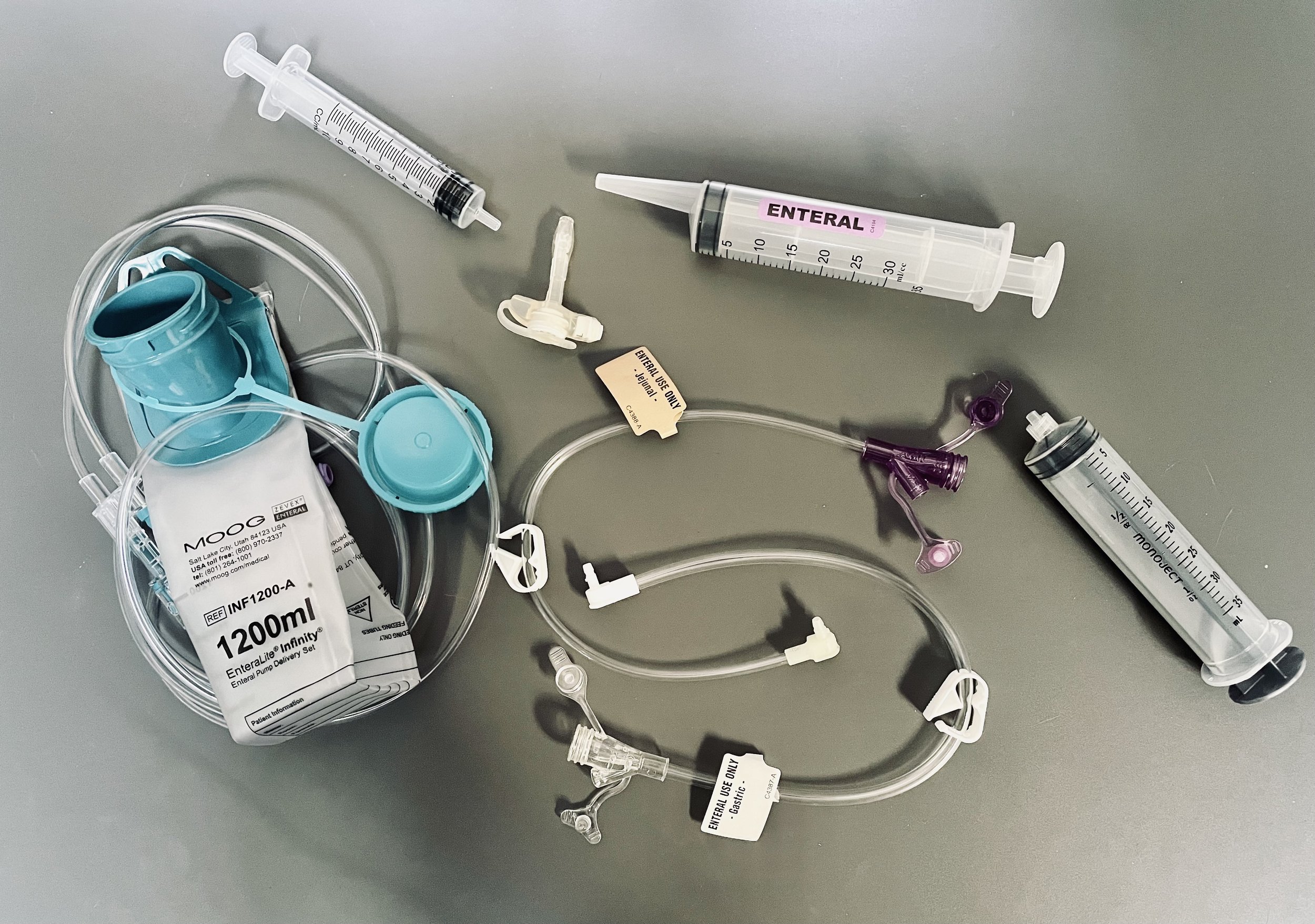The ENFit Transition: Advice and Information for Families (by Jeneva Stone)
A photo of some of the supplies necessary for enteral feeding. Depicted are a g-tube “button” or “peg,” syringes (catheter tip, slip-tip, luer lock), a feeding bag, and g- and j-tube extension sets. The equipment is made of translucent plastic, with white, aqua and purple accents. These are all “legacy” supplies. Each of these has an ENFit version, but the Stone family does not have all of these pieces yet.
My son Rob is a 25-year-old artist and activist. He’s survived and thrived in his community because he has had access to enteral (or “tube”) feeding for all of his nutrition, hydration, and medication needs since the age of two. Tube feeding isn’t shameful; it’s just another way of eating, and Rob has grown into a healthy adult because of this life-saving adaptation.
Yet, Rob’s feeding disability leaves him vulnerable. Unlike his peers, Rob can’t buy disposable utensils at the market in a pinch, nor can he eat with his fingers if he has to. Rob eats and drinks using a system of medical feeding bags, extension sets, and specialized syringes covered by insurance, and available through medical suppliers. His life depends on the availability and compatibility of his supplies.
Two weeks ago, Rob and I first heard of the ENFit transition when our medical supplier told us his “legacy” enteral equipment would no longer be available. Many other families found out this fall when they began receiving mixed lots of supplies: ENFit and their usual. This is creating mind-boggling problems for tens of thousands of American families.
Centers for Medicare and Medicaid Services (CMS) data from 2013 estimate there are 189,036 pediatric and 248,846 adult enteral users in the United States, for a total of 437,882 people.
As of 2020, the Feeding Tube Awareness Foundation estimated that ⅔ of U.S. enteral users had successfully transitioned to ENFit products, leaving ⅓ of users yet to transition. If you’re one of the remaining 146,000 families who are just learning about ENFit, you’re not alone.
ENFit is an effort to standardize all connectors in enteral feeding systems, for two good reasons:
To reduce medical errors: the variety of syringes and connectors available (luer lock, slip-tip, catheter-tip, and Christmas tree) fit both tube feeding equipment and many other medical systems, including IV, catheters, tracheostomy, etc.
To prevent accidental disconnection of feeding tubes, which can easily happen with the legacy connectors, and to reduce leaks.
Rob Stone at a neighborhood party. Rob is seated in his wheelchair and wearing a light blue wheelchair cape. His cheek has been painted with a Rolling Stones logo, the red and white lips and protruding tongue.
In 2006, hospitals, families, suppliers, and others became concerned about medical mistakes made with tube-feeding connectors that had resulted in deaths. A trade organization called the Global Enteral Device Supplier Association (GEDSA) was formed to study the issue. GEDSA recommended standardizing all enteral supplies, and an awareness campaign began in 2014, with a planned transition to take place between 2015 and 2018. The Oley Foundation and the Feeding Tube Awareness Foundation were instrumental in getting the initial word out to families. The Oley Foundation has an archive of articles about the ENFit transition. The online resource Complex Child has a great article on ENFit’s benefits.
However, not all families are active with these organizations, nor do they attend conferences on enteral feeding. Many families simply rely on Medicaid, their private insurer, and/or their medical supply company to keep them informed.
Between 2018 and 2022, the ENFit transition stalled, for reasons that are not clear. Then in mid-2022, the legacy supplies families relied on began to vanish, because manufacturers discontinued them, apparently without adequate advance notice to suppliers or families.
The sudden disappearance of legacy enteral supplies is causing serious problems for many families, right now, without adequate support or assistance from GEDSA or any other organization, including the FDA and Medicaid. Some families are receiving only some ENFit components, and not others. Many families have reported that their medical supply companies are refusing to provide ENFit syringes, which makes it impossible for families to administer vital medications, or, in some cases, hydrate or feed their loved ones, as ENFit and legacy supplies are not compatible.
Giving medication through a syringe sounds relatively easy, but if you are an enteral user, your syringe, your extension set, your medication bottle dispenser cap, and, if you use one, your medication delivery bag must all have compatible connectors.
Many suppliers are claiming that syringes are the responsibility of pharmacies, which, you should know, is not true. Both private insurers and Medicaid pay suppliers for a daily enteral “package,” which is supposed to include syringes–although the number of them is not specified. If you aren’t getting syringes, your medical supplier may be cheating Medicaid or your insurance company in order to increase profits.
What is even more alarming? Many manufacturers of medical supplies are using the ENFit transition to price gouge and profiteer. On Amazon, ENFit syringes are selling for up to 10 times the cost of luer lock, slip-tip, or catheter tip syringes. It is difficult to find syringe adaptors online, and prices for these are excessive, as much as $100 per adaptor.
While families can purchase some ENFit and ENFit-adaptor products in bulk at Health Care Logistics (a wholesale company), bulk purchase is expensive! While nozzle adaptors are only $0.46 apiece on that site, you must buy 100 of them, spending $46. The same goes for bottle adaptors for medications, which run over $130 per 100. You can research more products here, but most are not available for sale to families. Enteral feeding bags and extension sets are not typically available for direct purchase, either.
Besides, many of our families do not have that kind of cash–disability is expensive enough as it is in our society, and the net result of the ENFit transition? Many families are stranded with no immediate options other than to pay through the nose for adaptive equipment, all while fighting with suppliers to ensure that insurance-covered and compatible products are actually delivered. Our loved ones need their medications, food, and hydration now; they cannot wait several months while this situation is resolved.
What can you do? You can contact your insurance company or State Medicaid authority to request information on the availability of ENFit supplies, as well as the number and type of syringes that are supposed to be provided by your supplier. You can also access resources at the Oley Foundation and the Feeding Tube Awareness Foundation to familiarize yourself with ENFit products. You can contact GEDSA and ask them how ENFit adapters can be made available cheaply for families who need them, as well as their plans for addressing profiteering by manufacturers and suppliers, the entities GEDSA represents.
Jeneva Stone is the Little Lobbyists Blog Manager.


